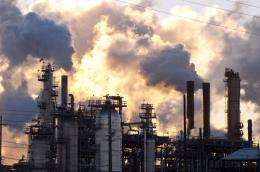New research measures the cost of getting cleaner air

(Phys.org)—Extensive environmental regulations have brought cleaner air and health improvements to the United States, but they also have increased the cost of manufacturing and reduced industrial productivity, according to a study by economists at the University of Chicago and MIT.
Some economists have suggested that the regulations encouraged companies to become more efficient, thus reducing costs at upgraded plants. But in a paper published by the National Bureau of Economic Research, three economists contend that the regulations led to a 4.8 percent decline in productivity and reduced profits by nearly 9 percent from 1972-93.
The annual cost to companies was about $21 billion, according to the paper, "The Effects of Environmental Regulations on the Competitiveness of U.S. Manufacturing," by Michael Greenstone, the 3M Professor of Environmental Economics at MIT; John List, the Homer J. Livingston Professor of Economics at the University of Chicago; and Chad Syverson, professor at the University of Chicago Booth School of Business.
"There are good reasons to think environmental regulations might increase production costs, but we didn't know how large the effect might be," said Syverson. "We are not saying that the regulations are a bad idea, but we wanted to know the cost." The paper examined how the total factor productivity (TFP) of manufacturing plants was impacted by the regulations, which went into effect as a result of the Clean Air Act of 1970.
"This paper demonstrates that government policy can plan an important role in shaping TFP," List said. "To date, we have little credible empirical evidence on the magnitude of such policy effects, with our study providing among the first such estimates for environmental regulations."
The Clean Air Act provides a stringent intervention for companies that are found to be polluting. The EPA can dictate installation of pollution abatement technologies on manufacturing plants.
"The equipment is part of the plant's measured capital stock, but in itself is neither necessary nor useful for producing the plant's commercial output," Greenstone said. "A labor-input example of the same concept is the hiring of an environmental compliance officer for the plant."
Because not all communities are impacted equally by air pollution, the Environmental Protection Agency each year designates counties as either being in attainment of the standards for air quality or in a nonattainment status. The standards cover ozone, total suspended particulates, sulfur dioxide and carbon monoxide. The manufacturing plants in nonattainment counties are subject to strict enforcement.
In order to determine the economic impact of the regulations, the scholars compared changes in the productivity of high-emissions manufacturing plants in noncompliant counties to those of low-emissions plants in those counties as well as high-emissions plants in compliant counties.
They based their work on data gathered by the U.S. Census Bureau of company expenditures and profits. The study found that the regulations impacted different kinds of manufacturers quite differently.
"The largest declines in TFP are associated with ozone nonattainment, which incidentally is one of the most commonly emitted pollutants among our industries," the scholars point out.
The researchers found that the organic chemical industry—companies that produce turpentine or benzene, for instance—are the most impacted by the regulations. They experienced a 17 percent reduction in productivity during the study period in non-attainment counties. The industry is only regulated for ozone, but had an annual loss of $9.2 billion during the study period when measured in 2010 dollars.
The scholars also looked at how companies increased their prices in order to compensate for their increased costs and studied the ready-mixed concrete industry specifically because it was a specialized industry that dealt with one common product. The study estimated that companies increased their prices by about one percent in response to the regulations.
The approach used to studying the impact of regulations brought on by laws could possibly be expanded to study in the impact of other regulations, the scholars said.
"In principle, this approach can be applied to the costs of regulations that govern firm behavior in a wide range of contexts," the paper says. "We envision similar exercises being fruitful in areas that regulate work and labor conditions, health and safety legislation."
Provided by University of Chicago


















